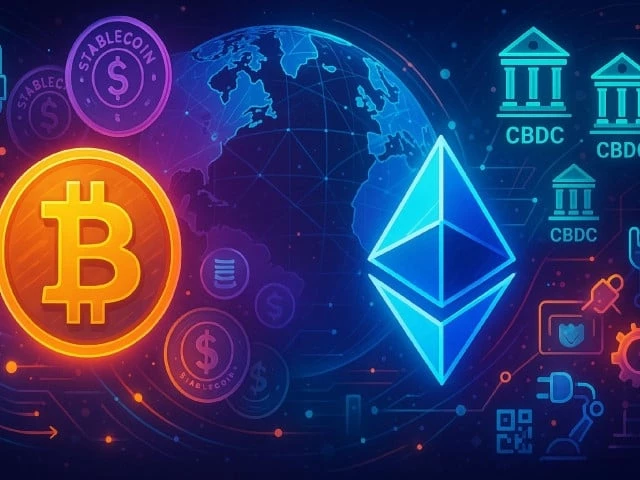Money just went digital, Bitcoin, Ethereum, stablecoins and CBDCs, Pakistan’s moment
Bitcoin has fortified its place as digital gold

Most people felt the shift without seeing it. Payments got faster, crypto stopped feeling fringe, and a new rulebook started to settle in. What changed is simple, and profound. The world is moving money onto programmable rails.
Some countries are building central bank digital currencies, CBDCs, and the United States is embracing fully reserved dollar stablecoins through a clear federal framework. Two paths, one destination, a digital monetary system that settles in seconds, speaks to software, and reaches anywhere a network can go.
The new American playbook, regulated stablecoins
In the United States, private companies can issue fully reserved dollar tokens under federal oversight. These tokens must be backed one to one by cash and short duration United States Treasuries, they must meet strict disclosure and compliance standards, and they must redeem at par.
That single design choice matters. Every new token creates steady demand for dollars and Treasury bills, which deepens the dollar’s reach in a digital world. Monetary policy still flows through the instruments the Federal Reserve already influences, only now those instruments back digital dollars that live in wallets and move at internet speed.
This is not only about speed, it is about precision. In the old world, policy moved through slow pipes and blunt tools. In the new world, digital dollars can be directed to a person, a region, a merchant category, or a time window. A government can airdrop relief to a city after a flood, it can set transaction rules for a specific program, it can even consider features like negative rates on a narrow slice of balances in an emergency.
A country that favors licensed stablecoin issuers can do this through regulated partners and payment networks, which turns money into a sharper policy instrument than the one we read about in classic textbooks.
Europe and China, public money on new rails
Europe is preparing a digital euro, China has piloted the e CNY for years. These are retail CBDCs, digital legal tender issued by a central bank, designed to work like cash in your phone, with strong privacy controls and offline features. Different governance, same purpose, fast settlement, clear rules, programmable money for a networked economy.
Bitcoin’s role, digital gold for the digital rails
Bitcoin has fortified its place as digital gold. It plays for the digital financial system the role gold has long played for the traditional one, a neutral, scarce, non sovereign store of value. This does not replace gold, it complements it. With each halving, new issuance slows, and over the next cycles supply becomes even more scarce.
In a world where money moves on programmable rails, a widely held reserve asset that sits outside any single government’s control provides a familiar anchor. Bitcoin fills that role for a growing share of portfolios, treasuries, and long term savers.
Real world assets, the other half of the story
If stablecoins are digital cash, real world assets are the digital bonds, bills, and funds that sit beside that cash. Treasuries, money market funds, repo, and even slices of private credit are moving onchain. When a dollar token and a tokenized Treasury live on the same ledger, collateral moves instantly, settlement becomes one click, yield pays straight into a wallet, and portfolios behave more like software. This is why Wall Street cares. Not because of slogans, but because the plumbing is better, the audit trail is stronger, and the cost is lower.
Why Ethereum matters so much
Ethereum is where much of this tokenization is happening today. The network has been live for nearly a decade, has weathered real stress, and has not suffered a catastrophic protocol failure. It is programmable, mature, and well understood by developers, auditors, custodians, and large institutions. That makes it a natural home for tokenized Treasuries, tokenized funds, and fully reserved stablecoins.
The standards are stable, the tooling is robust, and the network effects are real. When large issuers and asset managers choose a settlement layer for real world assets, they tend to choose the chain that has run reliably for years and already speaks the language of finance.
This does not mean there is only one chain. Solana has become a serious option for high throughput consumer payments and trading. Other networks bring useful tradeoffs, lower fees, faster finality, and different security assumptions.
What matters is simple, cash and assets must sit on programmable rails, and moving between chains should feel as seamless as moving between bank accounts. Bridges, custody networks, and common token standards are improving that experience month by month.
Fintech and traditional finance, the glue that makes it usable
Wallets make this simple for people and for businesses. Fiat on ramps and off ramps connect salaries, invoices, and subscriptions. Banks, trust companies, and qualified custodians hold reserves and run attestations.
Fund administrators and transfer agents bring regulated structure to tokenized funds. Payment processors and card networks add merchant acceptance. Compliance analytics and identity providers monitor flows in real time. The result is a stack that looks familiar to CFOs and regulators, only now it runs in real time, shows its work on chain, and can be programmed to fit policy and business logic.
AI, robotics, and machine to machine money
Over the next fifteen to twenty years, AI agents and robots will transact constantly. A car pays for charging, a device buys compute, a factory orders parts, a supply chain reconciles in the background. These are machine to machine payments. They need instant settlement, clear identity, and embedded rules. CBDCs and stablecoins both fit that need. Bitcoin sits beside them as a neutral reserve asset, and Ethereum provides a widely adopted environment for contracts, identity, and tokenized collateral. Together, these layers give automated economies the financial plumbing they require.
Geopolitics and global connectivity
The Middle East is already active in cross border CBDC projects, Europe is building a digital euro, Asia has large pilots, and the United States has chosen a regulated private issuance model for digital dollars. Over time these networks will interoperate. A merchant in Dubai, a freelancer in Karachi, and a manufacturer in Vietnam will settle with each other in seconds, with finality, and with rules that satisfy local regulators.
Pakistan’s moment, from undocumented to digitized
Pakistan is taking bold steps to bring crypto and blockchain into a regulated framework. The authorities are setting out clear guardrails for responsible innovation, and the direction is visible. Build the rules, connect to global rails, invite capital and talent, and protect consumers.
This shift can do more than modernize payments. Pakistan has a large undocumented economy. As the country adopts digital payment rails, tokenization, and compliant crypto activity, everyday transactions become easier to trace, taxes become simpler to collect, and credit can flow based on real data rather than guesswork.
Documentation is not a punishment, it is how small businesses graduate into formal finance, how exporters settle faster, and how households build a verifiable economic record. If Pakistan keeps moving with clarity and care, this effort can become a real engine for growth, jobs, and trust in the system.
The takeaway
Money is becoming a digital platform. Stablecoins create a steady bid for dollars and bills. Bitcoin provides a scarce, neutral reserve for the digital age. Ethereum anchors tokenized assets and programmable settlement, with other chains adding speed and choice for specific use cases. CBDCs bring public money onto new rails.
Fintech glues the experience together, from wallets to on ramps to acceptance. The public sector keeps the core safe, the private sector builds great user experiences, and the economy finally runs on rails designed for the internet.
If you build, focus on wallets, identity, and the integrations that make this invisible for users. If you invest, understand how Bitcoin and real world assets fit into a digital portfolio that settles in seconds. If you regulate, treat CBDCs and stablecoins as complementary tools that strengthen policy transmission and improve market plumbing. The shift already happened, now the work is to scale it with care.
Faisal Aftab is CEO of Zayn VC , the most active investor into the Pakistani financial infrastructure especially on the intersection of Finance, AI and Blockchain.


















COMMENTS
Comments are moderated and generally will be posted if they are on-topic and not abusive.
For more information, please see our Comments FAQ